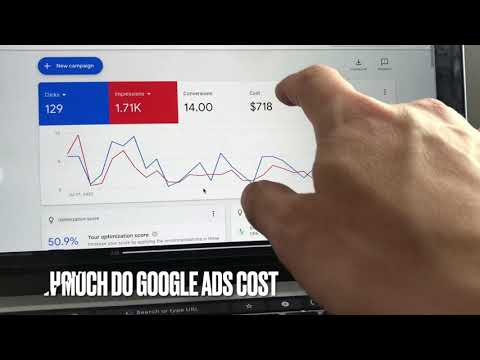When it comes to online advertising, nothing reigns supreme quite like Google. It’s like the mythical Mount Olympus of search engine results, where businesses battle it out for a prime spot.
But how exactly does this behemoth of a platform determine the cost of its paid search results? Enter the world of GoogleAds and the wild realm of keyword bidding.
Choosing the right keywords can mean the difference between soaring click-through rates or plummeting into obscurity. With factors like industry, bidding, and ad quality at play, it’s a delicate dance to balance cost and effectiveness.
Ready to delve deeper? Let’s unravel the mysteries of Google’s paid search cost together.
Table of Contents
- google paid search cost
- Paid Search Results On Google’s SERP
- Using Google Ads For Search Ad Campaigns
- Identifying The Best Keywords With Google Keyword Planner
- Relevance And Search Volume In Keyword Selection
- Factors Influencing Keyword Pricing
- Understanding Quality Score For Effective Paid Search Marketing
- Industry Impact On Keyword Costs
- Customer Lifecycle And Current Trends In Cost And ROI
- Strategies For Managing And Optimizing Google Ads Costs
google paid search cost
The cost of Google paid search varies depending on several factors. When using Google Ads, businesses can run search ads and pay per click.
The pricing for keywords is influenced by the number of businesses bidding on them, with more competitive industries typically having higher costs. Quality Score, which measures the relevance and quality of ads, also affects the cost and effectiveness of paid search marketing.
Factors such as industry, customer lifecycle, and current trends can impact the cost and return on investment. Budgeting is crucial to effectively manage costs, taking into consideration factors like daily budget and average daily spend.
On average, the cost per click ranges from $1-2 on the Search Network and even less on the Display Network. However, the most expensive keywords can cost $50 or more per click.
Key Points:
- Google paid search cost varies depending on several factors, including industry competitiveness and Quality Score.
- Businesses can run search ads and pay per click using Google Ads.
- Factors such as industry, customer lifecycle, and current trends can impact the cost and return on investment of paid search marketing.
- Budgeting is crucial for effectively managing costs, considering factors like daily budget and average daily spend.
- The cost per click on average ranges from $1-2 on the Search Network and less on the Display Network.
- However, some keywords can cost $50 or more per click, making them the most expensive.
Sources
https://ads.google.com/intl/en_au/home/resources/articles/what-is-paid-search/
https://www.wordstream.com/blog/ws/2015/05/21/how-much-does-adwords-cost
https://one.google.com/about/plans
https://www.wordstream.com/blog/ws/2022/05/18/search-advertising-benchmarks
Check this out:
? Pro Tips:
1. Take advantage of long-tail keywords: Long-tail keywords tend to have lower search volumes but higher intent, making them a cost-effective option for targeting specific and highly relevant audiences.
2. Utilize ad scheduling: By scheduling your ads to run during peak times or when your target audience is most likely to be active, you can optimize your budget and ensure your ads are seen by the right people at the right time.
3. Implement ad extensions: Ad extensions not only enhance the visibility of your ads but also improve their performance and click-through rates. By including extensions like sitelinks, callouts, and call extensions, you can provide more relevant information to potential customers and increase the value of your ads.
4. Regularly monitor and optimize your campaigns: Keeping a close eye on your campaign performance is essential for identifying areas of improvement and optimizing your budget. Continuously testing and making adjustments based on data and insights will help you get the most out of your paid search investment.
5. Consider remarketing campaigns: Remarketing campaigns allow you to target individuals who have already shown interest in your products or services. By retargeting these users with tailored ads, you can increase conversions and maximize your ROI.
Paid Search Results On Google’s SERP
When you search for something on Google, you may have noticed that there are some results at the top of the search engine results page (SERP) that have an “Ad” label next to them. These are the paid search results, and they appear at the top of the page because businesses have paid to have their websites shown there.
This prime placement increases the visibility of these websites and can significantly impact click-through rates.
Using Google Ads For Search Ad Campaigns
To run paid search ads on Google, businesses need to set up a Google Ads account. This account allows them to create and manage search ad campaigns.
The cost of these campaigns is determined by a pay-per-click (PPC) model, which means businesses only pay when someone clicks on their ads. This makes Google Ads a cost-effective advertising option, as businesses only pay for actual clicks and not just impressions.
Identifying The Best Keywords With Google Keyword Planner
Choosing the right keywords is crucial for increasing click-through rates and maximizing the effectiveness of paid search campaigns. Google Keyword Planner is a powerful tool that can help businesses identify the best keywords to target.
By entering relevant terms or phrases, businesses can get insights into search volume, competition, and other valuable metrics. This information guides businesses in selecting keywords that are not only relevant to their products or services but also have a significant search volume.
Relevance And Search Volume In Keyword Selection
When choosing keywords for a paid search campaign, businesses need to consider both relevance and search volume. Relevance ensures that the ad is shown to the right audience, increasing the chances of attracting qualified leads.
Meanwhile, search volume indicates the popularity of the keyword, giving businesses an idea of how many people are searching for that term. Striking a balance between relevance and search volume is essential for maximizing click-through rates and achieving the desired results.
Factors Influencing Keyword Pricing
The cost of keywords in Google Ads depends on various factors, including the number of businesses bidding for them. The more businesses bidding on a particular keyword, the higher the price is likely to be.
Additionally, the industry in which the business operates plays a significant role in keyword pricing. More competitive industries often have higher keyword costs due to increased competition for top ad placement.
Understanding these factors can help businesses budget and allocate their ad spend effectively.
Understanding Quality Score For Effective Paid Search Marketing
Google Ads uses a Quality Score to assess the relevance and quality of ads. The Quality Score considers factors such as click-through rates, ad relevance, and landing page experience.
A high Quality Score can positively impact both the cost and effectiveness of paid search marketing. Ads with higher Quality Scores are rewarded with lower costs per click and better ad placements, making it essential for businesses to strive for a high Quality Score to optimize their campaigns.
Industry Impact On Keyword Costs
The industry in which a business operates can greatly influence the cost of keywords. More competitive industries, such as insurance, legal, and education, often have higher keyword costs due to increased competition.
This competition drives up the prices businesses need to bid in order to secure top ad placement. It is important for businesses to be aware of the average keyword costs in their industry to budget effectively for their paid search campaigns.
Customer Lifecycle And Current Trends In Cost And ROI
The customer lifecycle and current trends can also impact the cost and return on investment (ROI) of Google Ads campaigns. Different stages of the customer lifecycle may have different cost implications.
For example, targeting customers in the awareness stage may be less expensive compared to targeting those in the decision-making stage. Additionally, keeping up with current trends and adjusting strategies accordingly can help businesses stay competitive and maximize their ROI.
Strategies For Managing And Optimizing Google Ads Costs
Managing and optimizing Google Ads costs is crucial for maximizing profits. Proper account structure and optimization can help businesses in this endeavor.
By organizing campaigns, ad groups, and keywords in a logical manner, businesses can better control their costs and improve campaign performance. Additionally, utilizing strategies for bidding and budget allocation, such as dayparting and geotargeting, can help businesses allocate their budget effectively and drive maximum results.
Long-tail keywords can also be a cost-effective option, as they often have lower competition and stronger user intent.
In conclusion, understanding the various factors that influence Google’s paid search cost is paramount for businesses looking to maximize their profits. By selecting the right keywords, considering relevance and search volume, understanding keyword pricing factors, optimizing Quality Score, and aligning strategies with industry and customer trends, businesses can effectively manage and optimize their Google Ads costs.
It is essential for businesses to continually monitor and adjust their campaigns to ensure they are getting the desired results and achieving a strong return on investment.












